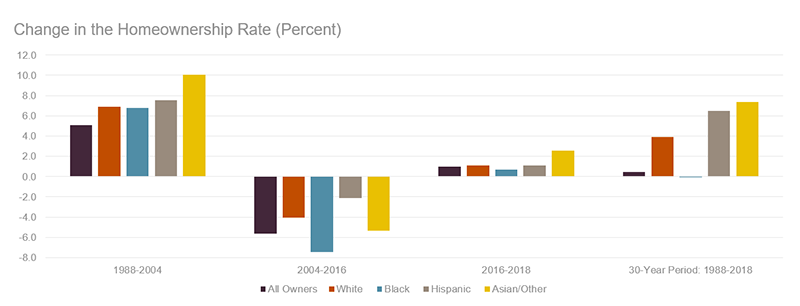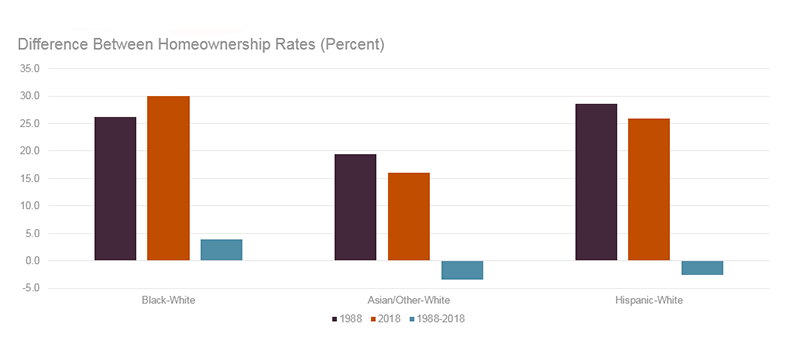Rebounds in Homeownership Have Not Reduced the Gap for Black Homeowners
Although homeownership rates rose for all racial and ethnic groups in 2016-2018, rates for black owners rose at a slower pace than for other groups. Consequently, the longstanding gap between black and white homeownership rates increased and is now larger than it was three decades ago.
The black homeownership rate remains the same as it was in 1988. However, homeownership rates for Hispanics and Asians/others increased more than those for whites during this period, resulting in narrowing the gaps between whites and Hispanics, as well as for whites and Asian/others.
The homeownership rate increased a full percentage point in 2016-2018 to 64.4 percent in 2018. Asian and other minorities showed the highest increase at 2.6 percentage points, followed by whites and Hispanics each increasing by 1.1 percent, while the black homeownership rates rose by 0.7 percentage point. Following these increases, the white homeownership rate in 2018 was 73.0 percent, followed by Asian/other households at 57.0 percent, Hispanics at 47.1 percent, and blacks at 42.9 percent.
Figure 1: The Size of the Homeownership Rate Rebound in 2016-2018 Varies by Race/Ethnicity
Note: Blacks, whites, and Asians/others are non-Hispanic. Hispanics may be of any race.
Source: JCHS tabulations of US Census Bureau, Housing Vacancy Surveys.
The relative sizes of the homeownership rate increase across groups resemble the longer-term trends in homeownership rates since 1988, and do not appear to be related to the sizes of the homeownership rate declines experienced from 2004-2016. Of particular note, the rebound in the homeownership rate is smallest among black households, the group that suffered the largest homeownership rate decline from 2004-2016. The result is that the black homeownership rate of 42.9 percent in 2018 is no higher than its rate thirty years ago. Because the white homeownership rate increased 3.9 percentage points during this period, however, the white-black homeownership gap actually widened from 26.2 percent in 1988 to 30.1 percent in 2018.
In contrast, the robust increase in the homeownership rate of Asian, multiracial, and other non-Hispanic minorities outpaced the increase among white households, narrowing the homeownership rate gap between these groups. The 2018 homeownership rate among Asian/other households is 2.6 percent percentage points higher than in 2016 and 7.3 percentage points higher than in 1988. These increases narrowed the white-Asian/other homeownership gap from 19.4 percent in 1988 to 17.5 percent in 2016 and 16.0 percent in 2018. Meanwhile, from 2016 to 2018 the 1.1 percentage point increase in the homeownership rate of Hispanic households equaled the rebound among whites. While the white-Hispanic homeownership rate gap is therefore unchanged from 2016-2018, it has narrowed over the longer term from 28.6 percent in 1988 to 26.0 percent in 2018.
Figure 2: The Black-White Homeownership Gap Has Increased Over the Past 30 Years
Note: Blacks, whites, and Asians/others are non-Hispanic. Hispanics may be of any race.
Source: JCHS tabulations of US Census Bureau, Housing Vacancy Surveys.
As evidenced by the data, homeownership rates have been increasing for all groups since at least 2016. However, the growth has been particularly low for black homeowners, the group most affected by declines in homeownership rates before, during, and after the Great Recession. This suggests a need to pay close attention to black households’ access to and experiences with homeownership with the goal of identifying policies and programs that will better foster sustainable homeownership opportunities to reverse this inequitable, long-term trend.



